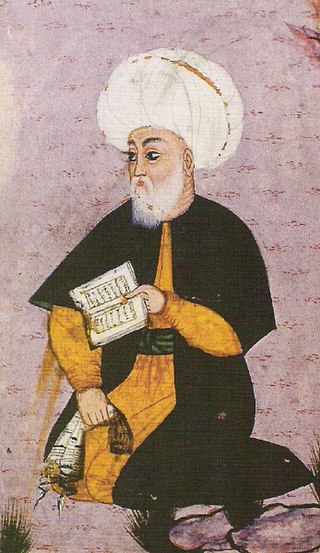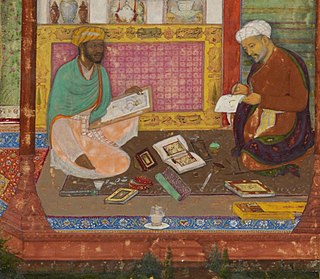History
The Ottoman Divan poetry tradition embraced the influence of the Persian and, to a lesser extent, Arabic literatures. As far back as the pre-Ottoman Seljuk period in the late 11th to early 14th centuries CE, this influence was already being felt: the Seljuks conducted their official business in the Persian language, rather than in Turkish, and the poetry of the Seljuk court was highly inflected with Persian.
When the Ottoman Empire arose in northwestern Anatolia, it continued this tradition. The most common poetic forms of the Ottoman court, for instance, were derived either directly from the Persian literary tradition (the gazel ; the mesnevî ), or indirectly through Persian from the Arabic (the kasîde ). However, the decision to adopt these poetic forms wholesale led to two important further consequences: [1]
- the poetic meters (Persian: beher (Arabic: بَحْر); Turkish: aruz (Arabic: عَرُوض)) of Persian poetry were adopted.
- Persian- and Arabic-based words were brought into the Turkish language in great numbers, as Turkish words rarely worked well within the system of the Persian poetic meter.
Out of this confluence of choices, the Ottoman Turkish language—which was always highly distinct from standard Turkish—was effectively born. This style of writing under Persian and Arabic influence came to be known as "Divan literature" (Turkish divân edebiyatı), as divân was the Ottoman Turkish word referring to the collected works of a poet.
Beginning with the Tanzimat reform period (1839–1876) of Ottoman history and continuing until the dissolution of the empire in the early 20th century, the Divan poetic tradition steadily dwindled, and more and more influence from both Turkish folk literature and European literature began to make itself felt.

Jalāl al-Dīn Muḥammad Rūmī, or simply Rumi, was a Persian 13th-century poet, Hanafi faqih, Islamic scholar, Maturidi theologian and Sufi mystic originally from Greater Khorasan in Greater Iran.

Mehmet Fuat Köprülü, also known as Köprülüzade Mehmed Fuad, was a highly influential Turkish sociologist, turkologist, scholar, Minister of Foreign Affairs and Deputy Prime Minister of the Republic of Turkey. A descendant of the prominent Köprülü family, Fuat Köprülü was a key figure in the intersection of scholarship and politics in early 20th century Turkey.

Seyid Ali Imadaddin Nasimi, commonly known as Nasimi, was a 14th- and 15th-century Hurufi poet who composed poetry in his native Azerbaijani, as well as Persian and Arabic languages. He is regarded as one of the greatest Turkic poets of his time and one of the most prominent figures in Azerbaijani literature.

The ghazal is a form of amatory poem or ode, originating in Arabic poetry. Ghazals often deal with topics of spiritual and romantic love and may be understood as a poetic expression of both the pain of loss or separation from the beloved and the beauty of love in spite of that pain.

Persian literature comprises oral compositions and written texts in the Persian language and is one of the world's oldest literatures. It spans over two-and-a-half millennia. Its sources have been within Greater Iran including present-day Iran, Iraq, Afghanistan, the Caucasus, and Turkey, regions of Central Asia, South Asia and the Balkans where the Persian language has historically been either the native or official language. For example, Rumi, one of the best-loved Persian poets, born in Balkh or Wakhsh, wrote in Persian and lived in Konya, at that time the capital of the Seljuks in Anatolia. The Ghaznavids conquered large territories in Central and South Asia and adopted Persian as their court language. There is thus Persian literature from Iran, Mesopotamia, Azerbaijan, the wider Caucasus, Turkey, Pakistan, Bangladesh, India, Tajikistan and other parts of Central Asia, as well as the Balkans. Not all Persian literature is written in Persian, as some consider works written by ethnic Persians or Iranians in other languages, such as Greek and Arabic, to be included. At the same time, not all literature written in Persian is written by ethnic Persians or Iranians, as Turkic, Caucasian, Indic and Slavic poets and writers have also used the Persian language in the environment of Persianate cultures.
The culture of Turkey or the Turkish culture combines a heavily diverse and heterogeneous set of elements that have been derived from the various cultures of the Eastern European, Eastern Mediterranean, Caucasian, Middle Eastern and Central Asian traditions. Many of these traditions were initially brought together by the Ottoman Empire, a multi-ethnic and multi-religious state spanning across Southern Europe, Eastern Europe, the Middle East and North Africa.

The culture of the Ottoman Empire evolved over several centuries as the ruling administration of the Turks absorbed, adapted and modified the various native cultures of conquered lands and their peoples. There was influence from the customs and languages of nearby Islamic societies, while Persian culture had a significant contribution through the Seljuq Turks, the Ottomans' predecessors. Despite more recent amalgamations, the Ottoman dynasty, like their predecessors in the Sultanate of Rum and the Seljuk Empire were influenced by Persian culture, language, habits, customs and cuisines.Throughout its history, the Ottoman Empire had substantial subject populations of Orthodox subjects, Armenians, Jews and Assyrians, who were allowed a certain amount of autonomy under the millet system of the Ottoman government, and whose distinctive cultures were adopted and adapted by the Ottoman state.
Turkish literature comprises oral compositions and written texts in the Turkish language. The Ottoman form of Turkish, which forms the basis of much of the written corpus, was highly influenced by Persian and Arabic literature, and used the Ottoman Turkish alphabet.

Azerbaijani literature is written in Azerbaijani, a Turkic language, which is the official state language of the Republic of Azerbaijan, where the North Azerbaijani variety is spoken. It is also natively spoken in Iran, where the South Azerbaijani variety is used, and is particularly spoken in the northwestern historic region of Azerbaijan. Azerbaijani is also spoken in Russia, Georgia and Turkey.

A Persianate society is a society that is based on or strongly influenced by the Persian language, culture, literature, art and/or identity.

Muhammad bin Suleyman, better known by his pen name Fuzuli, was a 16th-century poet who composed works in his native Azerbaijani, as well as Persian and Arabic. He is regarded as one of the greatest poets of Turkic literature and a prominent figure in both Azerbaijani and Ottoman literature. Fuzuli's work was widely known and admired throughout the Turkic cultural landscape from the 16th to the 19th centuries, with his fame reaching as far as Central Asia and India.

In Islamic cultures of the Middle East, North Africa, Sicily and South Asia, a Diwan is a collection of poems by one author, usually excluding his or her long poems (mathnawī).
Islamic culture or Muslim culture refers to the historic cultural practices that developed among the various peoples living in the Muslim world. These practices, while not always religious in nature, are generally influenced by aspects of Islam, particularly due to the religion serving as an effective conduit for the inter-mingling of people from different ethnic/national backgrounds in a way that enabled their cultures to come together on the basis of a common Muslim identity. The earliest forms of Muslim culture, from the Rashidun Caliphate to the Umayyad Caliphate and the early Abbasid Caliphate, was predominantly based on the existing cultural practices of the Arabs, the Byzantines, and the Persians. However, as the Islamic empires expanded rapidly, Muslim culture was further influenced and assimilated much from the Iranic, Caucasian, Turkic, Indian, Malay, Somali, Berber, and Indonesian cultures.

Ahmed Effendi, better known by his mahlasNedîm, was an Ottoman lyric poet of the Tulip Period. He achieved his greatest fame during the reign of Ahmed III. He was known for his slightly decadent, even licentious poetry often couched in the most staid of classical formats, but also for bringing the folk poetic forms of türkü and şarkı into the court.
Mihri Hatun, also known as Lady Mihri and Mihri Khatun, was an Ottoman poet. She was the daughter of a kadi and according to sources she spent most of her life in and near Amasya, in Anatolia. Documentation places her as a member of the literary circle of Prince Ahmed, the son of Sultan Bayezid II. She is referred to as the "Sappho of the Ottomans".
The composite Turko-Persian, Turco-Persian, or Turco-Iranian is the distinctive culture that arose in the 9th and 10th centuries in Khorasan and Transoxiana. According to the modern historian Robert L. Canfield, the Turco-Persian tradition "was "Persianate" in that it was centered on a lettered tradition of Iranian origin; it was Turkish in so far as it was for many generations patronized by rulers of Turkic ancestry; and it was "Islamicate" in that Islamic notions of virtue, permance, and excellence infused discourse about public issues as well as the religious affairs of the Muslims, who were the presiding elite."
The time that can be called contemporary in Turkish literature falls in the period between the middle of the 20th century and the first years of the new millennium. Throughout this period many changes in literary discourse have occurred. Together with the fall of the Ottoman Empire and foundation of the Turkish Republic brought a different way to Turkish literature together with the effect of Westernization on Turkish writers. The literature of the new republic emerged largely from the pre-independence National Literature movement, with its roots simultaneously in the Turkish folk tradition and in the Western notion of progress. One important change to Turkish literature was enacted in 1928, when Mustafa Kemal initiated the creation and dissemination of a modified version of the Latin alphabet to replace the Arabic-based Ottoman script. Over time, this change—together with changes in Turkey's system of education— would lead to more widespread literacy in the country. In 1950s, Turkish authors started to write in the tone of their western contemporaries bringing a new sense of literature to the country.

İbrahim Şinasi was a pioneering Ottoman intellectual, founder of Turkish dramaturgy, author, journalist, translator, playwright, linguist and newspaper editor. He was the innovator of several fields: he wrote one of the earliest examples of an Ottoman play, he encouraged the trend of translating poetry from French into Turkish, he simplified the script used for writing the Ottoman Turkish language, and he was one of the first of the Ottoman writers to write specifically for the broader public. Şinasi used his newspapers, Tercüman-ı Ahvâl and Tasvîr-i Efkâr, to promote the proliferation of European Enlightenment ideals during the Tanzimat period, and he made the education of the literate Ottoman public his personal vocation. Though many of Şinasi's projects were incomplete at the time of his death, "he was at the forefront of a number of fields and put his stamp on the development of each field so long as it contained unsolved problems."
The earliest Crimean Tatar literary works are dated back to the times of the Golden Horde, while its golden era took place in the times of Crimean Khanate.
Nematullah Kishvari was a 15th- and 16th-century poet. He is considered one of the leading poets of Azerbaijani literature during that time and his poems played a significant role in the development of the Azerbaijani literary language.











